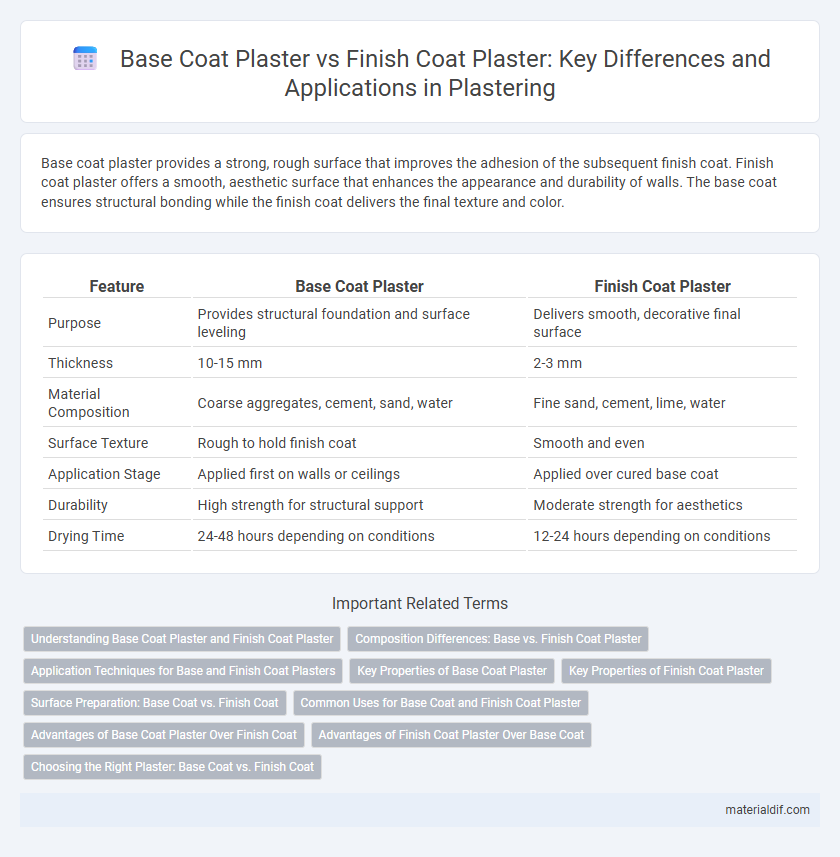Base coat plaster provides a strong, rough surface that improves the adhesion of the subsequent finish coat. Finish coat plaster offers a smooth, aesthetic surface that enhances the appearance and durability of walls. The base coat ensures structural bonding while the finish coat delivers the final texture and color.
Table of Comparison
| Feature | Base Coat Plaster | Finish Coat Plaster |
|---|---|---|
| Purpose | Provides structural foundation and surface leveling | Delivers smooth, decorative final surface |
| Thickness | 10-15 mm | 2-3 mm |
| Material Composition | Coarse aggregates, cement, sand, water | Fine sand, cement, lime, water |
| Surface Texture | Rough to hold finish coat | Smooth and even |
| Application Stage | Applied first on walls or ceilings | Applied over cured base coat |
| Durability | High strength for structural support | Moderate strength for aesthetics |
| Drying Time | 24-48 hours depending on conditions | 12-24 hours depending on conditions |
Understanding Base Coat Plaster and Finish Coat Plaster
Base coat plaster provides a strong, adhesive foundation layer that enhances the overall durability and bonding of wall surfaces. Finish coat plaster offers a smooth, refined surface that is ideal for decorating and painting, ensuring aesthetic appeal and resistance to cracking. Understanding the distinct purposes and application techniques of base and finish coat plaster is essential for achieving long-lasting, high-quality wall finishes.
Composition Differences: Base vs. Finish Coat Plaster
Base coat plaster typically contains a higher concentration of sand and gypsum, providing structural strength and adhesion to walls, while finish coat plaster has a finer composition with polymers and lime to ensure a smooth, durable surface. The base coat's coarse texture allows it to bond well with masonry, acting as a foundational layer, whereas the finish coat's fine, creamy mix is designed for aesthetic appeal and resistance to cracking. These composition differences optimize each plaster layer for its specific function in wall construction and surface finishing.
Application Techniques for Base and Finish Coat Plasters
Base coat plaster requires a rough surface application using a trowel to create a key for the finish coat, often involving multiple layers to build strength and durability. Finish coat plaster is applied more smoothly with fine troweling and sometimes a sponge float to achieve an even, decorative surface that is ready for painting or wallpapering. Proper curing times between coats are essential to prevent cracking and ensure strong adhesion between the base and finish layers.
Key Properties of Base Coat Plaster
Base coat plaster provides a strong, durable foundation with excellent adhesion and crack resistance, essential for preparing walls for the finish coat. It features superior workability and moisture control, helping to stabilize surfaces and prevent issues like blistering or peeling. Designed for rough application, base coat plaster ensures a smooth, level substrate that enhances the durability and appearance of the subsequent finish coat plaster.
Key Properties of Finish Coat Plaster
Finish coat plaster features a smooth, dense texture designed for aesthetic appeal and surface protection. It offers enhanced durability, resistance to cracking, and excellent adhesion to the base coat plaster, ensuring a long-lasting finish. Its composition often includes fine aggregates and additives for water resistance and ease of application, making it ideal for final decorative layers.
Surface Preparation: Base Coat vs. Finish Coat
Base coat plaster provides a rough, durable surface ideal for strong adhesion during surface preparation, ensuring long-lasting structural integrity. Finish coat plaster requires a smooth, clean base, often sanded or polished, to achieve an even, decorative appearance with enhanced aesthetic quality. Proper surface preparation for each coat is essential to optimize plaster bonding and overall wall performance.
Common Uses for Base Coat and Finish Coat Plaster
Base coat plaster is primarily used as the initial layer in plastering systems to create a rough, even surface that adheres well to the substrate and provides structural support for subsequent layers. Finish coat plaster is applied as the final layer to achieve a smooth, decorative, and paint-ready surface that enhances aesthetics and durability. Common uses for base coat plaster include wall leveling and surface preparation, while finish coat plaster is utilized for final surface refinement in residential and commercial interiors.
Advantages of Base Coat Plaster Over Finish Coat
Base coat plaster provides superior adhesion and structural support, creating a solid foundation for subsequent layers and enhancing overall wall durability. It offers excellent leveling properties, effectively smoothing uneven surfaces and filling imperfections to ensure a uniform base. Base coat plaster's greater thickness and robustness improve resistance to cracks and damage compared to the thinner, more delicate finish coat plaster.
Advantages of Finish Coat Plaster Over Base Coat
Finish coat plaster offers superior smoothness and enhanced surface durability compared to base coat plaster, making it ideal for final decorative finishes. It provides better resistance to moisture and wear, ensuring long-lasting aesthetic appeal. The finish coat's fine texture also facilitates improved paint adhesion and a polished, refined look.
Choosing the Right Plaster: Base Coat vs. Finish Coat
Base coat plaster provides a strong, level foundation essential for wall durability, while finish coat plaster ensures a smooth, polished surface ideal for painting or decoration. Selecting the right plaster depends on the specific stage of wall preparation--base coat plaster is applied first for structural support, whereas finish coat plaster is applied last to achieve aesthetic quality. Properly distinguishing between base coat and finish coat plasters enhances wall longevity and visual appeal in construction projects.
Base Coat Plaster vs Finish Coat Plaster Infographic

 materialdif.com
materialdif.com